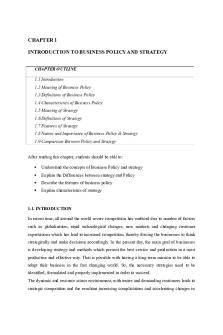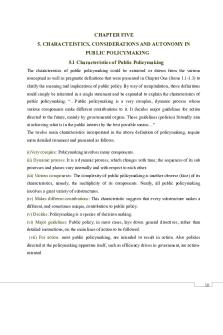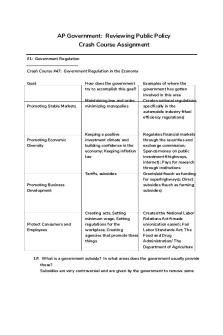Chapter 1 Notes - Business and Society: Stakeholders Ethics Public Policy PDF

| Title | Chapter 1 Notes - Business and Society: Stakeholders Ethics Public Policy |
|---|---|
| Course | Business, Government and Society |
| Institution | Singapore Management University |
| Pages | 5 |
| File Size | 78.9 KB |
| File Type | |
| Total Downloads | 83 |
| Total Views | 177 |
Summary
chapter 1 summary notes...
Description
WEEK 2 Chapter 1 – The Corporation and Its Stakeholders Walmart example - Template for 21st century capitalism - Provide great variety of products; “save money, live better” slogan indeed attracted many customers – helped American shoppers save money - Share price rose - Major customer for tens of thousands of suppliers worldwide - BUT received a lot of criticism – protests for higher wages and predictable schedules, bribery allegations, lawsuits, neighbourhood retailers read Walmart going out of business and thus people losing jobs, etc - As a result, company improved social performance through offering grants to small businesses, make packaged food healthier, donate, strengthened its ethics and compliance program, etc -
-
Challenges of managing successfully in complex global network of stakeholders – difficult to simultaneously satisfy multiple stakeholders with diverse and contradictory interests Company’s actions affected itself and many others; many had a stake in Walmart’s decisions
Business and society Business: any organisation that is engaged in making a product or providing a service for profit - Vary in size and impact Society: human beings and social structures they collectively create; segments of humankind Business is clearly a part of society, yet it is also separated by clear boundaries They are highly interdependent and impact each other Managers must understand their company’s key relationships and how the social and economic system affects and is affected by their decisions A systems perspective General systems theory: all organisms are open to, and interact with, their external environments Understand by understanding the relationship to surroundings - Business firms are imbedded in a broader social structure with which they constantly interact - Businesses must adapt to changes in environment; adapt effectively to changing conditions key business survival Interactive social system: business and society influence and affect one another - separate but connected Stakeholder theory of firm Ownership theory of the firm - firm is seen as the property of its owners; purpose of firm is to maximise long-term market value, make the most money it can for shareholders
Stakeholder theory of firm – corporations’ purpose is to create value for society; make profit for owners, professional development for employees, create innovative new products for customers; all stakeholders’ interests must be taken into account - 3 core arguments for supporters of stakeholder theory 1. Descriptive argument - Stakeholder view is a more realistic description of how companies work - Managers direct energies toward all stakeholders, not just owners 2. Instrumental argument - Stakeholder management is more effective - Perform better financially over the long run - Good relationships with stakeholders is a source of value for firm - Attention to stakeholders’ rights and concern can motivate them 3. Normative argument - Stakeholder management is simply the right thing to do - All stakeholders contribute something of value - Whoever that makes a contribution or takes a risk have the moral right to some claim on corporation’s rewards Fiduciary: person who exercises power on behalf of another - Managers are considered fiduciaries of owners Stakeholder concept Stakeholder: those that affect or are affected by an organisation’s decisions, policies, and operations Stake: interest in/ claim on a business enterprise Stakeholder =/ stockholder Stakeholders share risks and rewards and has some kind of claim on the firm’s resources and attention - A lot and high variety of stakeholders make company’s decisions very complex Managers pay attention of effects build strong relationship and stakeholders are an asset that adds value But some disregard stakeholders’ interests and results are costly Different kinds of stakeholders Market stakeholders: - Those that engage in economic transactions to provide society with goods and services - E.g. stockholders (receive potential for dividends and capital gains by investing), creditors (collect payments by loaning), employees (receive wages for contributing skills and knowledge), etc - Q: should managers be classified as stakeholders along with other employees Nonmarket stakeholder: - Do not engage in direct economic exchange but are affected by or can affect its actions - E.g. community, ngos, business support groups, competitors, public - Not necessarily less import than others - Interactions with such groups can be critical to firm’s success or failure
Internal stakeholders: those who are employed by firm e.g. employees and managers - “inside” the firm - Contribute at the company worksite External stakeholders: those who may have important transactions with firm but are not directly employed by it Government – controversial nonmarket stakeholder - Do not normally conduct direct market exchanges but money does flow in terms of taxes and fees, subsidies or incentives - Some businesses also sell directly to government and receive payment - Some cases, government may take direct ownership stake in company - Governments also have special influence over business due to ability to charter and tax corporations Other stakeholders e.g. business support groups, communities also have market and nonmarket characteristics Business firm and stakeholders are visualized as an interconnected network Some may play multiple stakeholder roles – role sets several stakes in company’s actions Stakeholder analysis Manager’s job to identify relevant stakeholders, understand their interests and power Identify issue, identify and map relevant stakeholders, understand the nature of their interests, power, legitimacy, and links with one another Stakeholder interests = Nature of each group’s stake Shareholders have ownership interest in firm, expect dividends and capital appreciation in exchange for investment Customers interested in gaining fair value and quality in exchange for purchase price of goods and services Etc Stake is broader than the financial stake of owners Managers need understand the complex and often intersecting stakeholder interests Stakeholder power = ability to use resources to make an event happen or to secure desired outcome 5 different kinds of power 1. Voting power - Legitimate right to cast a vote on major decisions such as mergers 2. Economic power - Suppliers, customers, employees, and others - E.g. suppliers can withhold supplies or refuse to buy a company’s products or services if company fails to meet contractual responsibilities - E.g. customers may refuse to buy company’s products or services if company acts improperly boycott - Depends on how well organized a stakeholder group is 3. Political power - By government through legislation, regulations, or lawsuits
-
Government agencies act directly, other stakeholders use political power to indirectly urge government - Stakeholders may also exercise political power directly to protest 4. Legal power - Stakeholders bring suit against a company for damages, based on harm caused by firm - E.g. customers and damages caused by defective products 5. Informational power - Access to valuable data, facts, or details + able to bring own info and perspectives to attention
Stakeholder coalitions Stakeholders interests often coincide form coalitions, temporary alliance to pursue common interest Companies may be both opposed and supported by coalitions Stakeholder coalitions are not static - Today highly involved, tomorrow less involved - Now controversial, uncontroversial later - Process of shifting coalitions does not occur uniformly in all parts of a large corporation Stakeholder salience and mapping It is suggested that managers pay most attention to stakeholders possessing greater salience More power, legitimacy, urgency stand out more Legitimacy – actions are proper or appropriate Urgency – time-sensitivity Stakeholder map – stakeholder salience x position on issue Corporation’s boundary-spanning departments Boundary spanning departments: departments or offices within an organisation that reach across the diving line that separates the company from groups and people in society Dynamic environment of business External environment of business is dynamic and ever changing produces both opportunities and threats Changing societal expectations - Society’s expectations of business are rising - Expect business to be more responsible, believing companies should pay close attention to social issues and act as good citizens - Businesses face daunting task of balancing social, legal, economic obligations - Need balance numerous stakeholders’ needs with their multiple obligations Globalisation - Increasingly integrated world economy, unceasing movement across borders - Large transnational corporations do business in scores of countries
Growing emphasis on ethical reasoning and actions - Businesses expected to be ethical - Ethics programs created to ensure employees are aware and act in accordance to ethical standards Evolving government regulations and business response Dynamic natural environment - All interactions between business and society occur within a finite natural ecosystem - Some resources are renewable while some are not - Relentless demands of human society exceeded carrying capacity of Earth’s ecosystem - Climate change threatens all Explosion of new technology and innovation - Become more connected and change has increased enormously - Extent and pace of technological innovation pose massive challenges for business seek to manage various privacy, security and intellectual property issues...
Similar Free PDFs

Business Policy notes
- 73 Pages

Interest Groups and public policy
- 10 Pages

Business Ethics - Lecture notes
- 83 Pages

Business Ethics and Ethos
- 36 Pages

Public Policy Essay
- 3 Pages

Public Policy Analysis paper
- 15 Pages

Public Policy Assignment
- 4 Pages

Public Policy - Elarba Badih
- 3 Pages
Popular Institutions
- Tinajero National High School - Annex
- Politeknik Caltex Riau
- Yokohama City University
- SGT University
- University of Al-Qadisiyah
- Divine Word College of Vigan
- Techniek College Rotterdam
- Universidade de Santiago
- Universiti Teknologi MARA Cawangan Johor Kampus Pasir Gudang
- Poltekkes Kemenkes Yogyakarta
- Baguio City National High School
- Colegio san marcos
- preparatoria uno
- Centro de Bachillerato Tecnológico Industrial y de Servicios No. 107
- Dalian Maritime University
- Quang Trung Secondary School
- Colegio Tecnológico en Informática
- Corporación Regional de Educación Superior
- Grupo CEDVA
- Dar Al Uloom University
- Centro de Estudios Preuniversitarios de la Universidad Nacional de Ingeniería
- 上智大学
- Aakash International School, Nuna Majara
- San Felipe Neri Catholic School
- Kang Chiao International School - New Taipei City
- Misamis Occidental National High School
- Institución Educativa Escuela Normal Juan Ladrilleros
- Kolehiyo ng Pantukan
- Batanes State College
- Instituto Continental
- Sekolah Menengah Kejuruan Kesehatan Kaltara (Tarakan)
- Colegio de La Inmaculada Concepcion - Cebu







